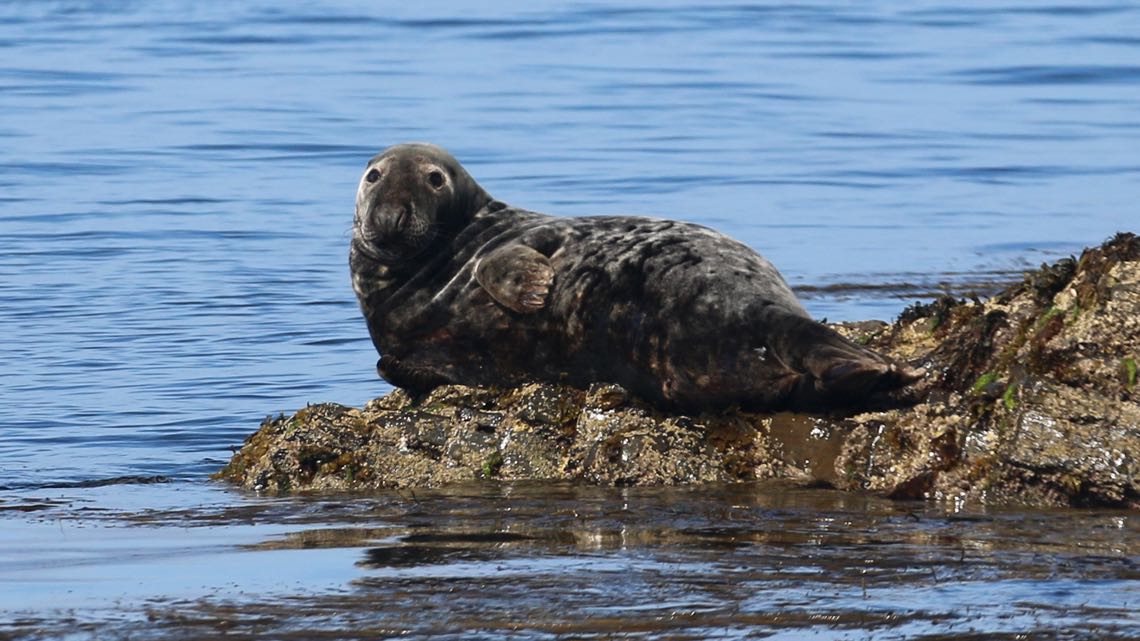
We’re lucky and often see these fantastic animals during our Wildlife Watching Tours along the mainland coast and in more abundance further off shore on the rocky Islets of Wolf Rock and Longships.
Description: Grey seals (Halichoerus grypus) have grey and brown fur, sometimes with a pattern of blotches; no ears visible; long muzzle; nostrils parallel; larger and darker than common seal, with flat or convex profile to its head (the common seal has a concave profile).
Size: Average for males 207cm; females 180cm; flippers about 25cm.
Weight: Males 233kg; females 155kg.
Lifespan: Female grey seals may live for 35 years, but males seldom survive to more than 25 years old.
Diet: Sand eels and cod are grey seal’s most important foods, but grey seals are opportunistic feeders and probably take whatever fish are most abundant.
General Ecology: Between the tides they haul themselves out on to rocks, usually on uninhabited offshore islands; though some haul-outs are on secluded mainland beaches. Grey seals are gregarious at these haul-outs, sometimes forming large groups of several hundred animals, especially when they are moulting their fur in the spring. They are not, however, very sociable and keep a distance between one another. About two-thirds of greys seals’ time is spent at sea where they hunt and feed. In the autumn grey seals congregate at traditional sites on land to breed. The timing of births varies around the coast, beginning in September in West Wales, in October in western Scotland, and as late as November in the Farne Islands.
Breeding: During the pupping season, male grey seals also come ashore to mate. The largest males, usually more than 10 years old, compete for a position within groups of breeding females. Occasionally males fight, and may sustain deep scars on their necks as a result.Grey seal pups weigh about 14kg at birth and have soft white fur. They remain on land where they suck from their mother for 18-21 days. A female’s milk contains up to 60% fat, so pups grow very quickly, gaining about 2kg in weight each day. This weight gain consists mainly of a layer of blubber below their skin, which is vital insulation when they go to sea.
Conservation Status: Grey seals were the first mammals to be protected by modern legislation – the Grey Seals Protection Act of 1914. Today, the Conservation of Seals Act (1970) protects them during a closed season from 1st September to 31st December, although seals causing damage at fish nets can still be killed. The law also allows complete protection to be given. For instance, grey seals in England and Wales, though not Scotland, were fully protected following the outbreak of phocine distemper in 1988.
Several grey seal culls have been undertaken, the most recent in Scotland in 1977. This resulted in a public outcry and the cull was abandoned in 1978 to await the results of more research into seals and fisheries. Recent research indicates that grey seals eat large quantities of sand eels, which are caught for use in fish meal but not for human consumption. Salmon does not appear to be an important part of the seal’s diet, although other commercially important fish like cod are taken. The relationship between numbers of seals and the incidence of fish parasite infestations is a complex issue. Problems of soil erosion on the Farne Islands have been relieved simply by discouraging seals from breeding on the most vulnerable islands.